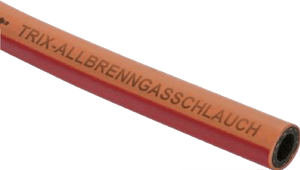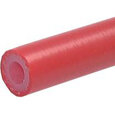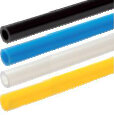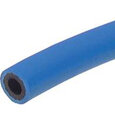How To Select The Right Hose For a Gas Facility
Choosing the right hose for a gas facility is a critical decision that directly impacts safety, efficiency, and overall operational success. With numerous factors to consider, such as gas type, pressure, temperature, and environmental conditions, selecting an appropriate hose requires careful evaluation. This article explores each of these factors in detail. Read our air and gas hose article to know more about the materials, hose requirements, and applications of gas hoses.
Selection criteria for gas hoses
Hoses used in gas facilities have specific features tailored to meet the unique requirements and safety standards of the industry.
Pressure and temperature
Select a hose with a working pressure and temperature higher than the application's specifications. This allows a safety margin, reducing the risk of hose failure and ensuring operational safety. It also allows for flexibility in accommodating future system changes or pressure fluctuations without the immediate need for hose replacement.
Size
Determining the appropriate hose size for a gas facility involves considering the required flow rate and pressure drop limitations.
- Calculate the required flow rate of gas: Determine the maximum amount of gas that needs to pass through the hose. Use our Kv calculator to determine the flow rate of the gas.
- Manufacturer specifications: Refer to the manufacturer's information to find suitable hose options based on flow rate and pressure requirements.
- Select the hose size: Choose a hose size that can accommodate the calculated flow rate and pressure drop limitations. Consider the physical limitations too during this step.
Materials
The hose material should be compliant with the gas passing through it. The most commonly used materials are listed below:
-
Metal corrugated hoses: Metal corrugated hoses have an inner core made of stainless steel or monel. These hoses are designed to prevent any permeation (discussed later), making them highly suitable for stationary gas applications.
- They are commonly used for handling helium and hydrogen gasses at pressures of 293 bar. Use hoses with a Monel inner core when dealing with corrosive gasses.
-
Metal hoses: Rigid metal hoses are specifically designed for stationary applications. They have limited flexibility and bending capabilities. However, they are priced economically, making them a cost-effective choice.
- They are used for conveying gasses such as compressed air, natural gas, propane, fuel gasses (such as hydrogen, methane, and butane), and certain industrial gasses.
-
Rubber hoses: Rubber hoses are flexible. They are widely available and affordable. However, rubber hoses may not be suitable for applications that require high levels of purity.
- Rubber hoses convey gasses like LPG, compressed air, and chemicals in various industries.
-
Ethylene tetrafluoroethylene (ETFE) hoses: ETFE hoses are flexible, durable, and cost-effective.
- ETFE hoses are suitable for conveying corrosive gases, inert gasses, high-purity gases, and industrial gases (such as compressed air, natural gas, and hydrogen). However, it is not suitable to transfer oxygen.
-
Polytetrafluoroethylene (PTFE) hoses: PTFE hoses are exceptionally flexible, durable, and suitable for applications involving high pressure (up to 200 bar). They are available at low prices.
- PTFE hoses are specifically known for their exceptional chemical resistance and are often preferred for more aggressive chemical applications involving natural gas, nitrogen, and oxygen.
-
PTFE post-sintered hoses: These hoses undergo a specific manufacturing process where the PTFE is baked again at a controlled temperature and pressure. This process enhances the hose's wall thickness and molecular bonds, reducing diffusion and effusion (discussed later). As a result, these hoses are typically suitable for pressures up to 250 bar.
- PTFE post-sintered hoses have similar gas compatibility to standard PTFE hoses.
Note: Use a chemical compatibility guide to check the suitability of each gas with various hose materials before deciding on a hose type.
Dynamic stress
Dynamic stresses occur when the gas is accelerated or decelerated during its handling, storage, or transport. Dynamic stresses can damage the hoses, leading to failure.
Evaluate the specific application in which the hose will be used. Consider whether the hose will be exposed to movement, vibrations, or sudden changes in gas flow or pressure during its handling, transport, or storage. Applications such as moving machinery, mobile equipment, or systems with frequent changes in gas flow can indicate a likelihood of dynamic stress. The velocity and flow rates of the gas should be lower than the recommended value for a specific hose to avoid cracks during operation.
- Metal hoses are prone to dynamic stress, and it is crucial not to bend them too much while transporting gasses. Also, corrugated metal hoses are not suitable for handling high flow rates or high-speed gas.
- Use hoses made of materials like Polyvinyl Chloride (PVC), Polyethylene (PE), and thermoplastic elastomers (TPE) for gas applications involving dynamic stress.
Permeation
Permeation in a gas hose is the process by which gasses can pass through the walls of the hose material through diffusion, leading to loss of gas, contamination, and safety hazards.
- Metal hoses offer better resistance to diffusion; use metal hoses where the purity of the medium is a concern.
- Look for hoses that have built-in barrier layers or coatings designed to reduce permeation.
- Regularly inspect the hose for signs of wear, damage, or degradation that may increase permeation. Replace hoses that show significant deterioration to maintain their integrity and minimize permeation risks.
FAQs
What factors should I consider when selecting a hose for a gas facility?
Consider factors such as gas type, pressure, temperature, compatibility, hose material, and industry standards to ensure the right hose selection.
Can I use hoses interchangeably between different gas facilities?
It is recommended to use hoses dedicated to specific gas facilities to avoid cross-contamination, ensure compatibility, and maintain safety standards.
How often should I replace hoses in my gas facility?
Regularly inspect hoses for wear, damage, or degradation, and replace them as needed to ensure optimal performance and avoid potential hazards. The frequency of replacement depends on factors such as usage, operating conditions, and manufacturer recommendations.











